Using a Variety of Advanced Functions
The LAG Function
A Brief Overview
Suppose you have the
Certadv.Stock6Mon data set that contains opening and closing stock
prices for the past six months for two different companies. You are
trying to determine which company has the bigger difference in the
daily opening price between consecutive days.
To start, consider what
you want the LAG function to return, as shown below.
Figure 14.1 Desired LAG Function Results for ABC Company, by Day
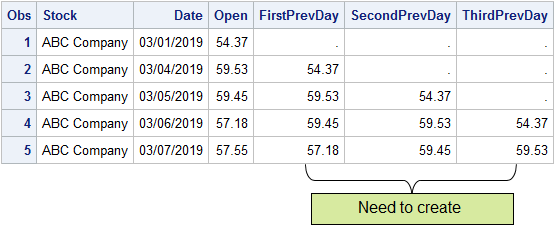
The LAG function enables
you to compare the daily opening prices between consecutive days by
retrieving the previous values of a column from the last time that
the LAG function executed.
LAG Function Syntax
The LAG function retrieves
a value from a previous observation. It is able to do so because the
function maintains a queue of the previous values. If you use LAG
or LAG1, you are looking for the previous value one row back. LAG2
gives you the previous value two rows back. LAG3 gives you the previous
value three rows back, and so on. The LAG function is useful for computing
differences between rows and computing moving averages.
|
Syntax, LAG function:
LAG<n>(column);
n
specifies the number
of lagged values.
column
specifies a numeric
or character constant, variable, or expression.
|
Example: Retrieving Previous Values
The following example
uses the LAG function to retrieve previous values using assignment
statements. The LAG function also creates new variables based on the
previous values of Open. Using March 6 as an example, the first previous
value is 59.45, the second previous value is 59.53, and the third
previous value is 54.37. These values are highlighted in the table
below.
Note: For the first observation,
there are no previous values to look up, so the assignment statement
returns a missing value. For the second observation, there is a first
previous value but no second and third previous values, and so on.
data work.stockprev; set certadv.Stock6Mon(drop=Close); FirstPrevDay=lag1(Open); SecondPrevDay=lag2(Open); ThirdPrevDay=lag3(Open); run; proc print data=work.stockprev; run;
Output 14.1 PROC PRINT Output of Work.StockPrev (partial output)
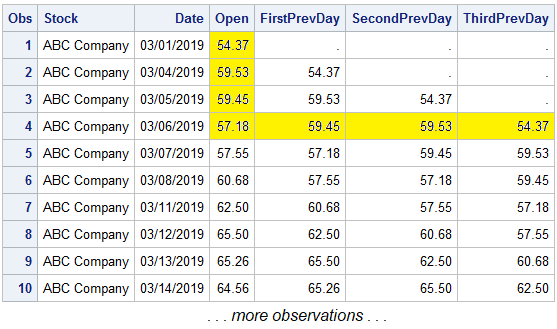
Example: Calculating a Moving Average
In addition to computing
differences between rows, you can calculate a moving average using
the LAG function.
Suppose you have stock
prices for the Random Company. The data set contains the opening stock
price for the first work day of each month. You need to calculate
a moving three-month average. Again, consider what you want the LAG
function to return, as shown below.
Figure 14.2 Desired LAG Function Results for Random Company, by Month
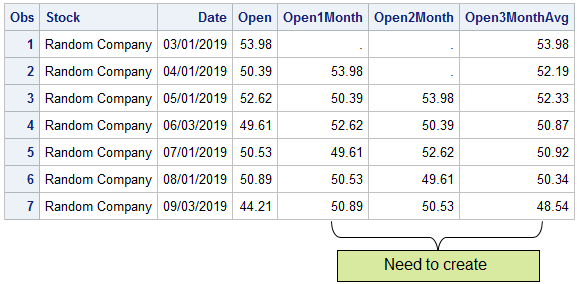
You can use the LAG
function to get the stock price for the past two months. The third
row is the first row that calculates an average based on three values.
data work.stockavg; set certadv.stocks(drop=Close); Open1Month=lag1(Open); Open2Month=lag2(Open); Open3MonthAvg=mean(Open,Open1Month,Open2Month); format Open3MonthAvg 8.2; run; proc print data=work.stockavg; run;
Output 14.2 PROC PRINT Output of Work.StockAvg
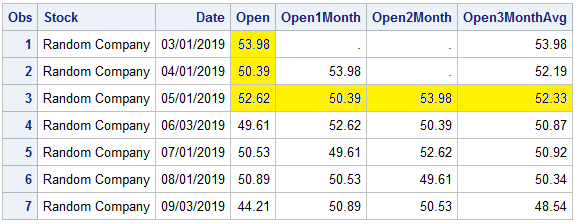
Note: The best practice is to create
a lagged value in an assignment statement before using it in a conditional
statement.
The COUNT/COUNTC/COUNTW Function
A Brief Overview
Suppose you have the
Certadv.Slogans data set, which contains numerous slogans that a company
can use for its business. You are asked to identify the number of
times a specific word, 24/7, was used in a slogan and how many words
were in a slogan. The slogans are separated by commas in a row.
You can use the COUNT
function to count the number of times a specific word such as 24/7
appears in the slogan, or you can use the COUNTW function to count
the number of words in a slogan. You could even use the COUNTC function
to count the number of characters in a slogan.
Note: Word is
defined as a character constant, variable, or expression.
COUNT/COUNTC/COUNTW Syntax
There are three variations
of the COUNT function. Note the slight difference in syntax for the
three functions.
|
Function Name
|
Syntax
|
Function Definition
|
|---|---|---|
|
COUNT
|
COUNT(string, substring <,modifiers>)
|
Counts the number of
times that a specified substring appears within a character string.
|
|
COUNTC
|
COUNTC(string, character-list <,modifiers>)
|
Counts the number of
characters in a string that appear or do not appear in a list of characters.
|
|
COUNTW
|
COUNTW(string <,delimiters><,modifiers> )
|
Counts the number of
words in a character string.
|
character-list
specifies a character
constant, variable, or expression that initializes a list of characters.
COUNTC counts characters in this list, provided that you do not specify
the V modifier in the modifier argument. If you specify the V modifier,
all characters that are not in this list are counted. You can add
more characters to the list by using other modifiers.
delimiters
can be any of several
characters that are used to separate words. You can specify the delimiters
by using the chars argument,
the modifier argument, or both.
modifiers
is a character constant,
variable, or expression that specifies one or more modifiers. modifiers is
an optional argument.
i or I
ignores the case of
the characters. If this modifier is not specified, COUNT counts character
substrings only with the same case as the characters in substring.
t or T
trims trailing blanks
from string, substring, and chars arguments.
string
specifies a character
constant, variable, or expression in which substrings are to be counted.
Tip
Enclose a literal string of
characters in quotation marks.substring
is a character constant,
variable, or expression that specifies the substring of characters
to search for in string.
Tip
Enclose a literal substring
of characters in quotation marks.Example: Counting the Number of Words
The following example
uses the COUNT function to count the number of times 24/7 appears
in the Slogans column. The COUNTW function counts the number of words
in the Slogans column. The COUNTW function does not specify any delimiter.
Therefore, a default list of
blank ! $ % & () * +
, - . / ; < ^ | is used. data work.sloganact; set certadv.slogans; Num24=count(Slogans,'24/7'); NumWord=countw(Slogans); run; proc print data=work.sloganact; run;
The COUNT function
returns the number of times 24/7 appeared in the Slogan column and
assigns the value to Num24. Notice that observation 5 contains 24/365.
However, this was not counted as a part of the 24/7. If you change
the string to search for to 24/, then 24/365 would appear in the Num24
column. The COUNTW function counts the number of words in each slogan
and assigns the value to NumWord.
Output 14.3 PROC PRINT Output of Work.SloganAct
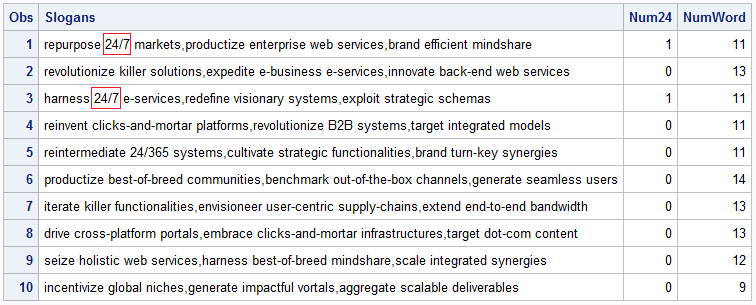
The FIND/FINDC/FINDW Function
A Brief Overview
Suppose you were asked
to identify the starting position of the first occurrence of 24/7
in a string. The FIND function finds the starting position of the
first occurrence of a substring in a string. Alternatives to the FIND
function are the FINDC and FINDW functions, which are also based on
finding the first occurrence. The FINDC function returns the starting
position where a character from a list of characters is found in a
string, and the FINDW function returns the starting position of a
word in a string or the number of the word in a string.
FIND/FINDC/FINDW Function Syntax
There are three variations
of the FIND function. Note the slight difference in syntax for the
three functions.
|
Function Name
|
Syntax
|
Function Definition
|
|---|---|---|
|
FIND
|
FIND (string, substring <,
modifiers><,
start-position>);
|
Searches for a specific
substring of characters within a character string.
Returns the starting
position where a substring is found in a string.
|
|
FINDC
|
FINDC (string, character-list <,
modifiers> <,
start-position>);
|
Searches a string for
any character in a list of characters.
Returns the starting
position where a character from a list of characters is found in a
string.
|
|
FINDW
|
FINDW (string, word<,
delimiters><,
modifiers> <,
start-position>);
|
Returns the character
position of a word in a string, or returns the number of the word
in a string.
|
character-list
is a constant, variable,
or character expression that initializes a list of characters. FINDC
searches for the characters in this list, provided that you do not
specify the K modifier in the modifiers argument.
If you specify the K modifier, FINDC searches for all characters that
are not in this list of characters. You can add more characters to
the list by using other modifiers.
delimiters
can be any of several
characters that are used to separate words. You can specify the delimiters
by using the chars argument,
the modifiers argument, or
both.
modifiers
is a character constant,
variable, or expression that specifies one or more modifiers.
i or I
ignores the case of
the characters. If this modifier is not specified, FIND searches
only for character substrings with the same case as the characters
in substring.
t or T
trims trailing blanks
from the string, word,
and chars arguments.
start-position
is a numeric constant,
variable, or expression with an integer value that specifies the position
at which the search should start and the direction of the search.
string
specifies a character
constant, variable, or expression that will be searched for substrings.
Tip
Enclose a literal string of
characters in quotation marks.substring
is a character constant,
variable, or expression that specifies the substring of characters
to search for in string.
Tip
Enclose a literal substring
of characters in quotation marks.word
is a character constant,
variable, or expression that specifies the word to be searched for.
Example: Finding the Word Number
You can use the FINDW
function to return the number of the word 24/7 in the Slogans string.
The third argument uses a blank to specify the delimiter separating
the words in the string. The E modifier tells SAS to count the number
of words instead of returning the starting position. The modifiers argument
must be positioned after the delimiters argument.
The E modifier is just one of the modifiers that can be used.
data work.sloganact;
set certadv.slogans;
Num24=count(Slogans,'24/7');
NumWord=countw(Slogans);
FindWord24=findw(Slogans,'24/7',' ','e');
run;
proc print data=work.sloganact;
run;
Output 14.4 PROC PRINT Output of Work.SloganAct (partial output)
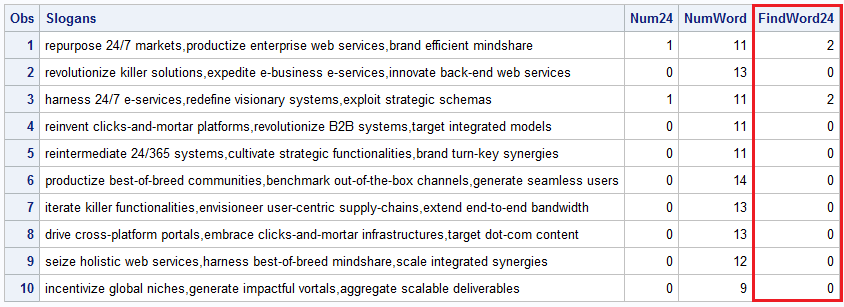
Last updated: October 16, 2019
..................Content has been hidden....................
You can't read the all page of ebook, please click here login for view all page.
